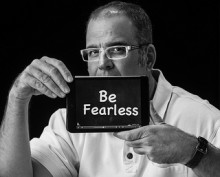In the beginning… I did not consider myself a visual person.
In any way, shape or form.
Having come from writing, I decided my blog would first and foremost be filled with WORDS.
And if you look back to the earliest days, you’ll find posts with loads of text (and hopefully some wit), but not too many visuals. In fact, here’s the first picture I used (a crappy stock shot and not integrated into the post at all).
Enter Paul M Bowers
Paul’s a photographer who gave a workshop on visual storytelling at Counselors Academy and suggested everyone use their own photos on their blogs.
I took Paul’s words to heart.
Paul noticed a recent photo of mine and was kind enough to offer some encouragement. So after I said thanks, I asked Paul if he’d answer a few questions for my blog and what follows is the first post in a short series on the importance of visual storytelling.
Let’s start with Paul describing himself in his own words (And yes, I recognize the irony that his stories below are in words…this is still a process for me):
“I’m no artist.
Yes, I’m a photographer and have been for more than thirty years. But unlike most photographers, I entered that crazy world from the origin point of Marketing. While searching for just the right spot as an agency account executive, I detoured, Marketing degree tucked under my arm, into a photo studio. And have only recently walked out. My goal was not to make pretty pictures; I wanted to help people sell things. And there is no salesman (or account executive!) quite as powerful as a visual image.
Whoever said a picture is worth one thousand words might have been accurate a hundred years ago. But now, one thousand words is probably missing the mark by a factor of 5-ish.
The velocity at which people consume modern media is so great, there is little time for words. People want to learn more at a faster pace and in a shorter time than ever, and our ability to absorb information via words is nowhere near the speed at which we can absorb information via imagery. And we like images. We like stories. We always have, since my teacher, Mrs. Hoss, created that magic moment when she would turn the book she read to the first-grade class around so we could see the pictures. And the magic of that moment never left me. I waited with anticipation and patience while she read all those damn words for that moment when I could see the pictures and illustrations.”
So what can communicators do to adapt to a visual world?
“First, hurry to the acceptance that as a writer, your cheese has been moved. Just like a mouse who’s been trained to run the maze to the destination for a morsel of Queso de Valdeón, some writers and PR professionals will repeatedly return to the same destination. But the cheese is gone. Not completely, of course, but images are far more powerful in a short period of time than words will ever be.
Historically, images were used as backup to a written message—consider the ubiquitous Press Release. Lots of words, a few pictures mostly shot by the interns, in the hope of enticing an “editor” to send a “reporter” and a “photographer” to do a “story” on one’s client. Those days are going, if not already gone.
First step to adaptation is the understanding and acceptance that the old ways have changed.”
Stock photos – yes or no and why?
“Nothing wrong with stock photos. Hey, why not use stock words, too? Next time you write a blog post, go online, find some sentences you like, copy them (pay the author if you’d like), and just paste them into your blog. Words are words, right?
Of course not.
Nothing wrong with stock images, but, just like words, they are rarely as powerful as images created by and for a specific purpose. Images that directly associate to content, that reflect the emotions and thoughts of the author.
If you wouldn’t use someone else’s generic words for your content, why would you use someone else’s generic images? To do so seriously undervalues the power of an image, and reflects a lack of understanding for that relocated Queso de Valdeón.”
Great advice. You don’t go to a site to buy cheesy headlines, why would you do that with your visuals? Stay tuned for more.


Great post Martin.
Dana Hughens Thanks Dana! Putting visuals first is a big shift for all writer types – or even giving them equal weight. I’m getting there slowly…
Stock words! Never thought about it like that. I’m a huge Paul fan, and I love seeing how he is really making PR people think about visual storytelling is becoming increasingly important in our day-to-day jobs. Great post.
maureenjudge Thanks! That’s for sure – and being in film, you know about that…
Thanks Martin. Paul M Bowers comments really hit home. It does feel like even more work now – and it is…but I believe that having to create your own images or working with someone to create them makes you have to think even harder and more clearly about what you are discussing.